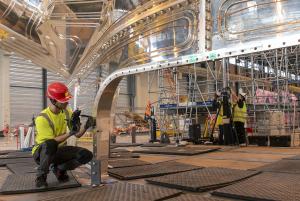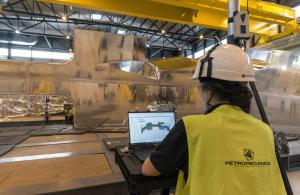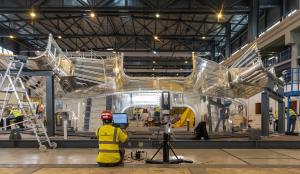Prévoir les déformations en amont des réparations
« Nous avons contribué à plusieurs essais, en particulier ceux réalisés sur les segments et les panneaux d'écran thermique de la chambre à vide, ainsi que sur une partie de l'écran thermique du cryostat : l'écran thermique de support », explique l'ingénieur en métrologie Lionel Poncet.
Les segments d'écran thermique sont constitués d'un assemblage de panneaux. Lors des essais sur les segments, plusieurs séquences de dépose des tubulures et de polissage ont été effectuées afin d'évaluer les déformations induites par certaines opérations. Au niveau des panneaux, les essais ont été réalisés sur les quatre à six panneaux que compte chaque segment, en les démontant du segment afin de les examiner séparément.
Pour déterminer les effets des réparations, il était nécessaire de quantifier certaines des causes responsables des variations, notamment la pression des structures de support, qui peut modifier la forme des panneaux d'écran thermiques car ceux-ci sont relativement minces. « Ces déformations peuvent être dues au support ou à l'opération de dépose des tubulures, explique Lionel Poncet, mais seules celles liées à la dépose des tubulures nous intéressent réellement, c'est pourquoi nous avons besoin de distinguer ces deux causes. Pour cela, il faut surveiller et contrôler l'environnement de support tout au long de l'intervention. Nous réalisons des mesures de référence avec et sans les structures de support afin d'évaluer la différence. »
Les changements de température sont eux aussi une source de variations car ils altèrent les mesures de distance réalisées par laser. Ce phénomène est compensé par un sous-système de l'instrument laser, grâce à un logiciel qui effectue des ajustements instantanés en fonction des mesures de température, de pression et d'humidité.
« L'équipe de métrologie d'ITER apporte régulièrement son appui aux unités d'ITER pour les aider à gérer leurs besoins de métrologie, dit Lionel Poncet. Lorsque, en 2022, nous avons reçu cette demande concernant l'écran thermique, nous avons commencé par déterminer la forme finale des différents éléments à mesurer afin d'établir des références pouvant être surveillées tout au long du processus. Les essais réalisés jusqu'au milieu de l'année 2023 ont contribué à la stratégie de réparation définie cette année-là, qui a été mise en œuvre après l'étape de sélection des entreprises chargées des réparations. »




